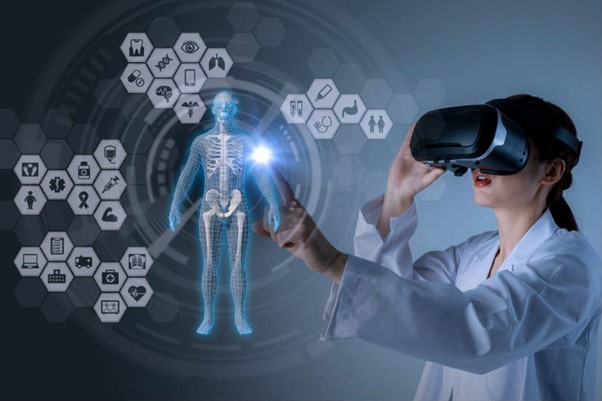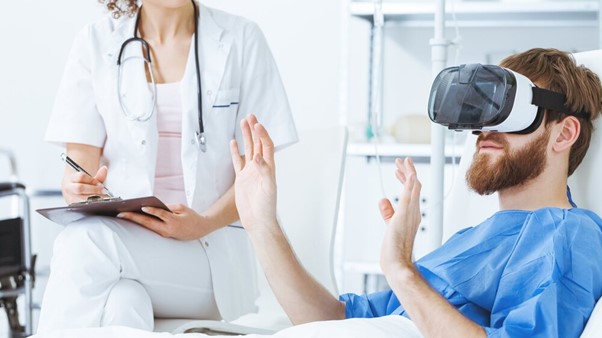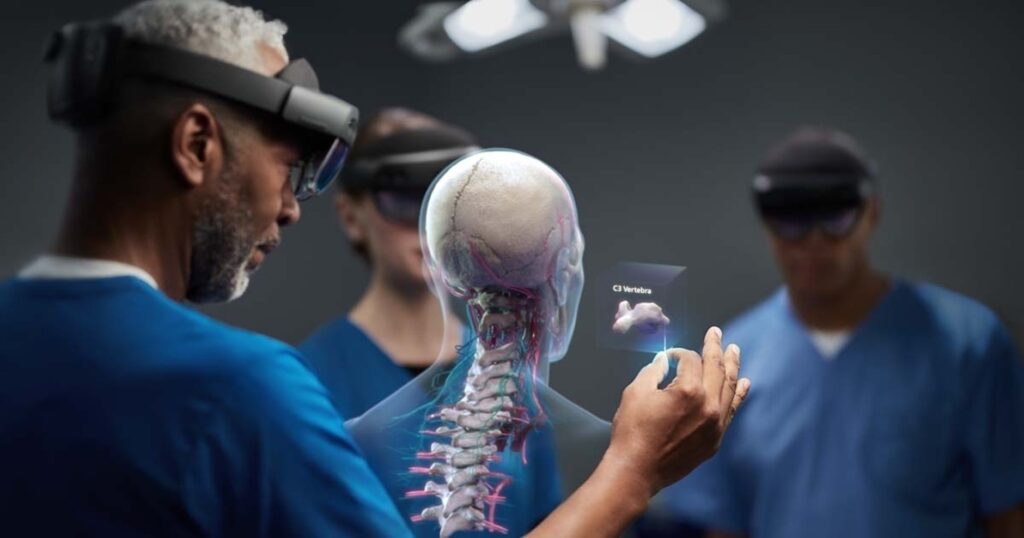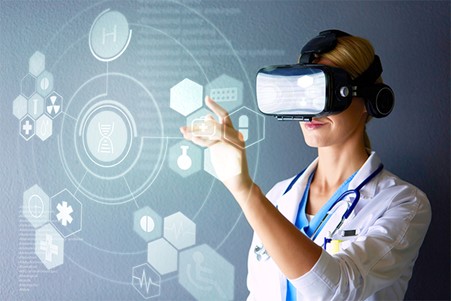XR Digital
At XR Digital, we blend creativity, technology, and strategy to deliver unparalleled digital solutions. Explore the possibilities with us as we push the boundaries of innovation and transform your vision into reality.

Virtual Reality (VR) has emerged as a groundbreaking technology with the potential to revolutionize various industries, and one field where its impact is particularly profound is medicine.
Augmented Reality (AR) and Virtual reality (VR) are two of the masterpieces in contemporary technology. Eight out of top ten tech companies are invested in and committed to these technologies including Apple, Microsoft, Google, Samsung, Intel, IBM, Foxconn, and HP. AR & VR, both elicit an immediate connection with gaming and entertainment.
The use of immersive, computer-generated technology in medicine, known as therapeutic virtual reality (VR), is fast gaining acceptance. Your doctor can already authorize a visit to a virtual reality world to relieve pain or anxiety or to explain a complex medical procedure or disease in some hospitals and clinics.
VR can be used in many areas of health care, such as medical training, patient treatment, medical marketing, and health education. VR has the potential to transform health care, delivering new types of treatments and diagnostics, and changing how and where care is delivered.
This article delves into the history, current trends, and advancements of virtual reality in medicine, exploring how this technology is shaping the future of healthcare.

When you put on a motion-sensing VR headset (and sometimes handheld controllers), your surroundings vanish. It is immediately replaced with a 360-degree virtual world into which you may enter, move around, and engage.
The experience feels real, and your brain processes it that way. If you need distraction from pain or stress, you may find yourself beneath the ocean, surrounded by dolphins. As you float along, you can look up and see the sun shining through the water’s surface. Look down and you see dolphins swimming around and below you. You can hear the echo of the underwater world and the sounds of the big mammals that surround you.

In the 1960s, virtual reality was born, and early experiments in medical training using rudimentary VR systems commenced. The subsequent decades witnessed advancements in computer graphics and hardware, leading to the development of medical simulators for surgical training.
These formative years laid the groundwork for the integration of VR into medical education, despite challenges and limitations.
VR therapy has been used, for over 20 years, in clinical healthcare including management of phantom limb pain, pain management in burn patients, brain damage assessment and rehabilitation, social cognition training for young adults with autism, meditation for treatment of anxiety and depression, stroke rehabilitation, Alzheimer’s, and management of ADHD in children.

The trends in virtual reality within medicine are diverse and impactful. Medical training and education now leverage simulation-based learning for students, offering immersive experiences for procedural skill development and anatomy education.
VR’s role extends to patient treatment and therapy, providing pain management solutions, exposure therapy, and rehabilitation. Moreover, telemedicine benefits from VR, enhancing the remote consultation experience and breaking barriers to healthcare access.

Virtual reality is employed in several applications in various sectors of healthcare. Medical training for both doctors in training and students, patient care, medical marketing, and educating people about a disease, medical condition, or process are examples of these. The global market for virtual reality is expected to exceed $4 billion by 2020. Some of the applications of VR in medicine are:
VR for pain control is one of the best-studied and most-used applications of the technology. Doctors have known for decades that this technological “distraction therapy” is an effective tool to combat pain and the fear of pain.
“Pain is a perception that’s coupled to your attention, mood, and emotions,”
VR can help reduce pain and anxiety by distracting the user from negative stimuli and creating a sense of presence in a virtual world. VR can be used along with medication to enhance pain relief for patients with acute or chronic pain, such as burn injuries, cancer, or fibromyalgia.
With VR, we can help modulate a patient’s mindset to be less focused on pain and anxiety.

Chemotherapy is a stressful and sometimes uncomfortable experience. Some medical centers now use VR to help their patients escape from anxiety or the boredom of treatments that can take hours.
VR can help patients cope with fear and stress before, during, or after a medical procedure, such as surgery, dental treatment, or blood draw. VR can provide relaxation, education, or exposure therapy to help patients overcome their phobias and increase their confidence.
Kids think of it like a video game. They use a joystick to zoom in through corridors in their brain, look at their tumor, and view things upside down. It brings kids into the process and takes away some of their fear.
VR can help patients improve their physical functions and mobility after a stroke, brain injury, spinal cord injury, or other medical condition.
With VR-based physical therapy and rehabilitation, therapists can choose software that helps the patient improve specific skills and targets individual problems. VR can simulate real-life situations and provide feedback and motivation to help patients practice their skills and achieve their goals.
Children with CRPS may experience agony every day of their lives. The therapist may employ a VR rehabilitation software in which they perform certain movements to squash watermelons. They can participate more fully in rehabilitation since they are now more focused on squashing those watermelons rather than on their agony.

VR can help medical students and professionals learn about human anatomy, physiology, pathology, and procedures in a realistic and immersive way. VR can also help them visualize complex medical concepts, such as congenital heart defects, brain tumors, or fractures.
Previous studies have shown that students who just get verbal instructions struggle far more to comprehend and solve issues than students who receive verbal and visual instructions. Since children in Kindergarten demand greater attention to increase their motivation in the classroom, a virtual reality environment provides an interactive way, which can help to keep them motivated and focused.
VR takes surgical collaboration to a new level. At the end of day this is all about improving safety. We discuss can ways to approach difficult cases, such as skull-based tumors. This kind of collaboration allows us to plan well in advance how to safely navigate through these small corridors in the brain to get to the tumor.
For patients, this can mean less time in the operating room and under anesthesia. For surgeons, it means they can push the envelope and safely explore new ways to do complex procedures.

VR can widely help in Marketing and Communication. VR can help healthcare providers and organizations promote their products and services, educate their customers and stakeholders, and enhance their brand image. VR can also help patients and their families understand their medical condition or treatment options and make informed decisions.
VR is still in its early days as far as medical applications are concerned. In the future, VR is likely to be increasingly used to enhance the safety and efficacy of surgical procedures, especially those which are minimally invasive or non-invasive, and to better understand the intricacies of the human body.
VR can help create and manipulate 3D models of organs and tissues, using data from medical imaging, such as MRI, CT, or ultrasound. VR can help researchers and engineers design and test new biomaterials, scaffolds, and bioreactors, and optimize the growth and function of engineered tissues. VR can also help surgeons implant and monitor the engineered organs and tissues in patients.

Technological advancements in virtual reality for medicine are accelerating. Haptic feedback now enhances the realism of VR applications, particularly in surgical simulations. The integration of artificial intelligence introduces diagnostic and decision-support systems, optimizing healthcare workflows. Meanwhile, wireless and mobile VR solutions contribute to increased mobility in healthcare settings, overcoming hardware constraints and broadening the scope of medical VR applications.
Real-world examples illustrate the success of virtual reality in various medical contexts. Surgeons benefit from VR simulations, reducing learning curves and improving skill retention, ultimately impacting patient outcomes and safety. Pain management sees success with VR applications, alleviating acute and chronic pain. Telemedicine experiences positive outcomes, showcasing improved patient engagement and satisfaction, addressing challenges, and hinting at prospects.

Despite its potential, therapeutic VR is not appropriate for every patient or medical condition.
VR is not a panacea for all ailments. And, in most circumstances, it is better utilized in conjunction with regular therapy rather than as a stand-alone treatment.
Most people have no trouble using VR. Some people experience “cybersickness,” which is nausea comparable to motion sickness. When you remove the headset, it goes away. Because of quicker hardware and software, this problem occurs less frequently. According to Spiegel, it affects around 5% to 10% of VR users.
As with any transformative technology, virtual reality in medicine faces ethical and technical challenges. Privacy concerns in virtual medical consultations and ensuring the ethical use of VR in education are critical considerations. Technical challenges involve overcoming hardware limitations, standardizing VR technologies, and ensuring interoperability with existing healthcare systems. Looking ahead, future possibilities include VR in personalized medicine, advancements in neurorehabilitation, and its role in preventive medicine and public health campaigns.

Virtual reality has evolved from its nascent stages to become a transformative force in the field of medicine. From revolutionizing medical education to enhancing patient treatment and therapy, the applications of VR in healthcare are vast and continually expanding. As technology advances and challenges are addressed, the future holds even more promising possibilities for the intersection of virtual reality and medicine, paving the way for a new era of patient care and medical innovation.
In the rapidly advancing landscape of healthcare technology, the transformative power of virtual reality (VR) stands out prominently, offering innovative solutions that align with XR Digital’s commitment to cutting-edge services. XR Digital, with its expertise in immersive technologies, is well positioned to leverage these advancements, contributing to the evolution of Digital World.
XR Digital offers its innovative services in Virtual Reality. XR Digital, with its commitment to cutting-edge technology, is positioned as a key player in shaping the future of the immersive Digital World, echoing the sentiments expressed in the exploration of VR’s applications in different businesses.
Virtual reality is utilized in medicine across various applications, including medical training, patient treatment, and diagnostics. In medical training, VR provides realistic simulations for surgical procedures, allowing practitioners to hone their skills in a risk-free environment.
The health benefits of virtual reality are extensive. VR is proven to be effective in pain management, reducing the perception of pain during medical treatments and promoting overall patient well-being. In rehabilitation, virtual reality facilitates physical and cognitive therapy, aiding in the recovery of patients with various impairments.
The initial use of virtual reality in healthcare dates back to the late 20th century. In the 1960s and 1970s, early experiments in medical training using rudimentary VR systems took place. However, it was in the 1990s that significant strides were made, particularly in surgical training and medical education, marking the beginning of the integration of virtual reality into various aspects of healthcare.
The importance of virtual reality lies in its ability to provide immersive and realistic experiences across diverse fields. In medicine, it enhances training, improves patient outcomes, and offers innovative solutions for pain management and rehabilitation. Additionally, VR has educational, entertainment, and industrial applications, making it a versatile and transformative technology.
At XR Digital, we blend creativity, technology, and strategy to deliver unparalleled digital solutions. Explore the possibilities with us as we push the boundaries of innovation and transform your vision into reality.